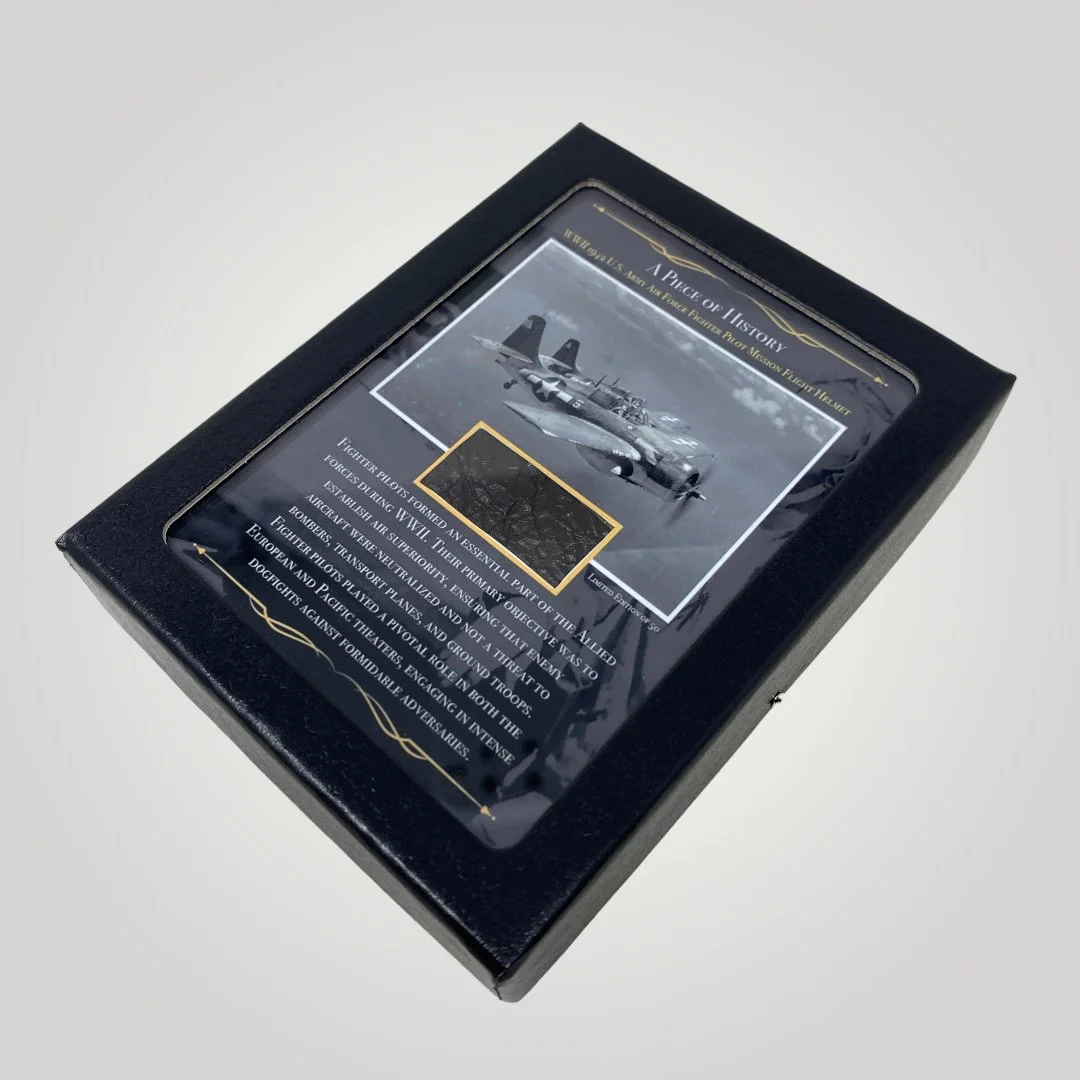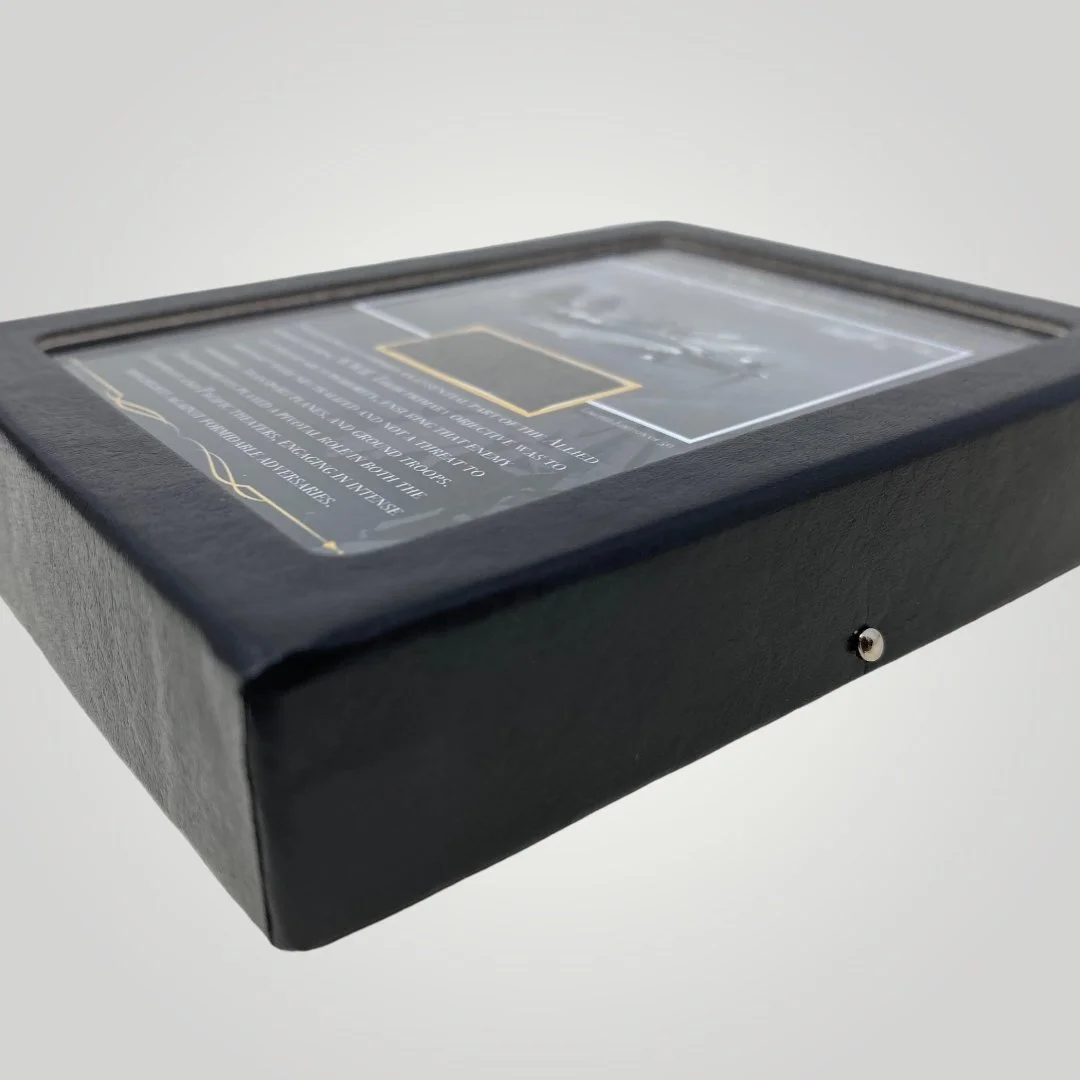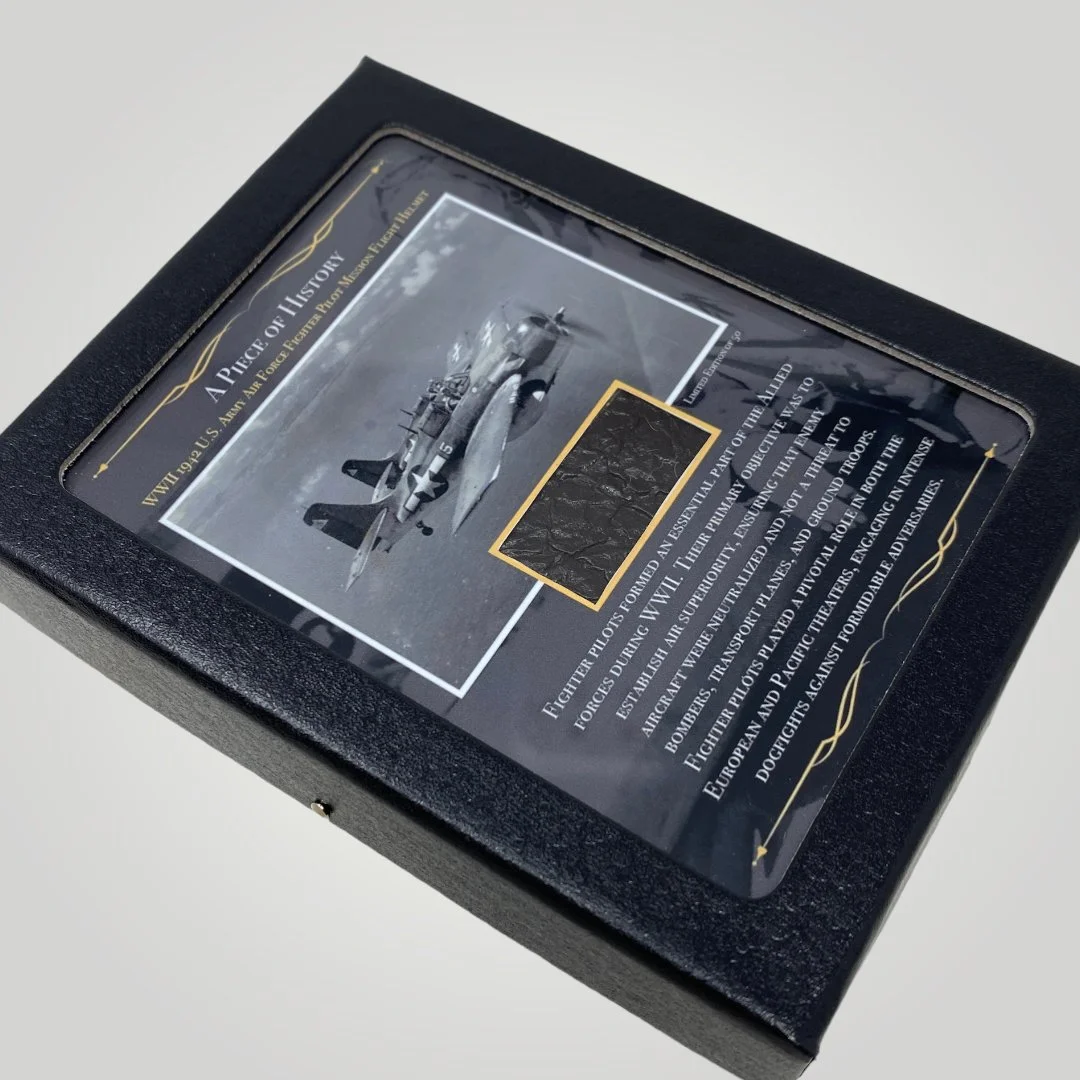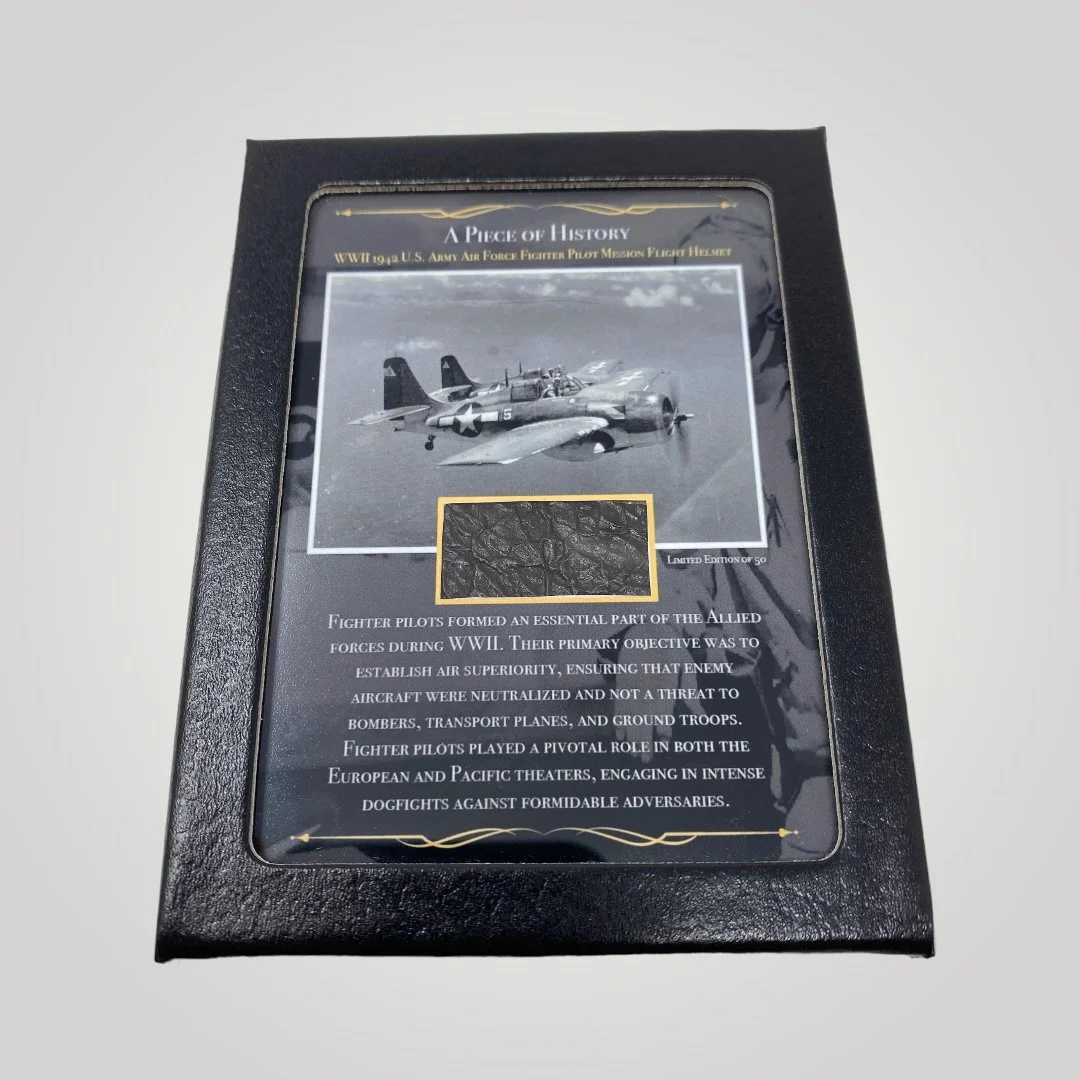RARE! WWII 1942 U.S. Army Air Force Fighter Pilots Combat Mission Flight Helmet with Display Case (C.O.A. Included)





















RARE! WWII 1942 U.S. Army Air Force Fighter Pilots Combat Mission Flight Helmet with Display Case (C.O.A. Included)
Comes with a hand-signed C.O.A. and a full historical research write-up.
*Limited Edition of 50*
Own your piece of history today!
Due to an incredibly high demand for display case options we are proud to offer one of our LIMITED EDITION series of HISTORIC DISPLAY CASE EXCLUSIVES. This incredible “Piece of History“ is professionally encased in a glass display case with plush padding and a tightly sealed display case. Each displays features a historical photograph and short description that corresponds to the artifact displayed. This display case measures a perfect 4.25 inches tall x 3.25 inches wide.
This series is a limited edition of 50 pieces, meaning that each “Piece of History” display is unique. The fighter pilot helmet artifact you receive may vary slightly from the display shown.
World War II (WWII) marked a pivotal era in human history, and the contributions of the U.S. Army Air Force (USAAF) played a critical role in shaping its outcome. Among the various units of the USAAF, the fighter pilots emerged as the embodiment of valor, determination, and technological prowess. This rare and very historic piece of WWII history is an original piece of WWII 1942 U.S. Army Air Force fighter pilot mission helmet.
Gear and Technology:
The U.S. fighter pilots of WWII were equipped with advanced and innovative gear that enabled them to effectively engage enemy aircraft and support ground operations. One of the most iconic fighter planes of the era was the P-51 Mustang, renowned for its speed, maneuverability, and long-range capabilities. Equipped with powerful engines and advanced avionics, the Mustang allowed pilots to engage enemy planes deep within enemy territory and provide crucial air cover to ground forces.
Fighter pilots also relied on state-of-the-art flight suits, helmets, and oxygen masks to withstand the extreme conditions of high-altitude combat. The development of these protective gears not only enhanced the pilots' comfort but also improved their performance during aerial engagements. The integration of radio communication systems further facilitated coordination among pilots and with ground control, enabling strategic maneuvering and timely decision-making.
Missions and Contributions:
The missions undertaken by U.S. fighter pilots were as diverse as they were demanding. Fighter squadrons engaged in a wide range of operations, including air superiority battles, ground support missions, escorting bombers, and reconnaissance. The strategic significance of these missions cannot be understated. Escorting bombers, for instance, was crucial in minimizing losses and ensuring the success of devastating air raids on enemy territories. The P-51 Mustang's long-range capability was instrumental in escorting bombers deep into German territory, thereby weakening the Luftwaffe and enhancing the Allies' bombing campaigns.
The Pacific Theater witnessed intense dogfights as U.S. fighter pilots clashed with Japanese counterparts in a bid for aerial dominance. The "Flying Tigers," a group of American volunteer pilots, gained legendary status for their efforts to defend China against Japanese aggression even before the U.S. officially entered the war. These early combat experiences laid the groundwork for the prowess and tenacity exhibited by U.S. fighter pilots throughout WWII.
Legacy and Impact:
The legacy of WWII U.S. fighter pilots extends far beyond their wartime contributions. Their dedication to duty and their exceptional combat skills helped shape the modern concept of air warfare. The tactics and strategies employed by these pilots served as templates for future generations of aviators and air force personnel. Furthermore, their heroism and camaraderie inspired countless stories, movies, and books that continue to capture the imagination of people worldwide.
The "Tuskegee Airmen," an all-African American fighter pilot group, shattered racial barriers and demonstrated the excellence of their skills despite facing discrimination and prejudice. Their achievements not only advanced civil rights but also paved the way for greater diversity and inclusion within the U.S. military.
World War II witnessed the emergence of exceptional fighter pilot aces whose courage, skill, and triumphs etched their names in history. These aviators soared through the skies, engaging in dogfights and aerial duels that captured the imagination of a world at war.
TOP ACES OF WWII:
Erich Hartmann: Erich Hartmann, a German Luftwaffe pilot, stands as the highest-scoring fighter ace in history, with an astounding 352 confirmed kills. Serving primarily on the Eastern Front, Hartmann's remarkable marksmanship, tactical brilliance, and determination earned him the nickname "The Black Devil." He excelled in the Messerschmitt Bf 109, engaging Soviet aircraft in fierce battles. Hartmann's achievements underline the dedication and prowess of a pilot who consistently outmaneuvered his opponents.
Richard "Dick" Bong: Among the ranks of the U.S. Army Air Forces, Richard Bong is celebrated as America's top-scoring fighter ace, with 40 confirmed victories. Flying the P-38 Lightning, Bong's expertise in aerial combat earned him the nickname "Ace of Aces." His combat record exemplified his mastery of aircraft and tactics, and he was awarded the Medal of Honor for his heroic actions during strafing runs on Japanese positions. Bong's achievements symbolize the dedication of American fighter pilots in the Pacific Theater.
Lydia Litvyak: Lydia Litvyak, known as the "White Rose of Stalingrad," was a Soviet fighter pilot who became one of the most famous women combat aviators of WWII. With 12 confirmed kills, she demonstrated remarkable skill and bravery while flying various aircraft, including the Yakovlev Yak-1. Litvyak shattered gender stereotypes, paving the way for future generations of female aviators and proving that women could excel in combat roles.
James "Johnny" Johnson: As a British Royal Air Force (RAF) pilot, James Johnson made significant contributions to the Allied war effort. With 34 confirmed kills, Johnson was known for his tactical acumen and his ability to lead formations effectively. He piloted the Supermarine Spitfire, becoming a symbol of British resilience during the Battle of Britain. Johnson's valor and leadership reflected the spirit of the RAF and its determination to defend the skies over Britain.
Saburo Sakai: Saburo Sakai, a Japanese naval aviator, stood out for his prowess as one of Japan's leading fighter pilot aces. Despite flying aircraft that were often outmatched by Allied counterparts, Sakai achieved 64 confirmed kills. His adaptability, resourcefulness, and determination to overcome adversity marked him as a true aviation legend. His memoir, "Samurai," provides insights into the life of a fighter pilot on the other side of the conflict.
The WWII U.S. Army Air Force fighter pilots, with their cutting-edge technology, indomitable spirit, and unparalleled valor, played a pivotal role in shaping the course of history. Their gear, missions, and legacy remain etched in the annals of military history, a testament to their enduring influence on air warfare and the ideals of duty, honor, and sacrifice. The stories of these brave men serve as a reminder of the heights that human determination can reach, even in the darkest of times.